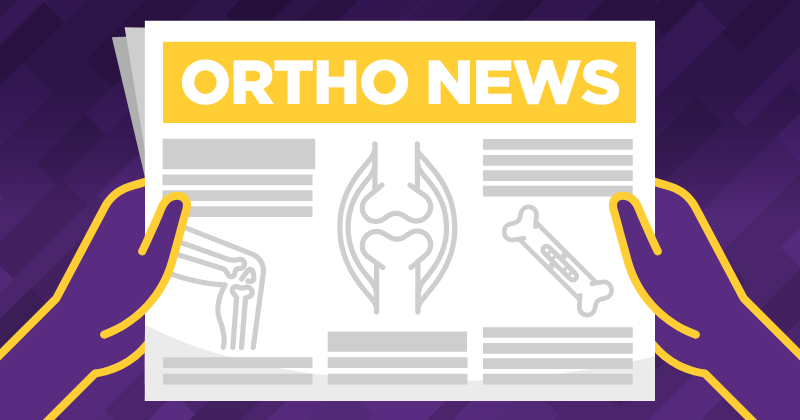What’s New In Orthopedics?

The orthopedic industry is constantly evolving, from innovative surgical advancements to supply chain management and improving patient care. While the global pandemic continues to affect almost every aspect of medicine, there are notable implications for orthopedic providers and practices. Here are the top four future trends in orthopedics to watch:
Recent years have seen an overall trend towards higher utilization of ambulatory surgery centers (ASCs), and migrating more approved procedures to them. In fact, a study recently published in the Journal of Bone and Joint Surgery1 found an 8.8% increase in annual procedure volume for orthopedic procedures performed at ASCs in the Medicare population from 2012–17.
A study recently published in the Journal of Bone and Joint Surgery found an 8.8% increase in annual procedure volume for orthopedic procedures performed at ASCs.
In the CY 2022 Medicare Hospital Outpatient Prospective Payment System and Ambulatory Surgical Center Payment System Final Rule, finalized on November 2, 2021, CMS decided to reinstate patient safety criteria and remove 255 procedures from the ASC Covered Procedures List (ASC CPL)2. This policy reversal means that certain procedures will no longer be reimbursable in the ASC setting. CMS’s current position is that a gradual assessment of patient safety considerations is more appropriate to move procedures to the ASC CPL.
As hospitals became ground zero for COVID-19 treatment, ASCs provided a cost-effective alternative for orthopedic procedures. Certain subspecialties became more comfortable performing procedures in ASC settings out of necessity. After hospitals banned elective inpatient procedures, spine surgeons at one ASC in New York3 tried procedures such as single-level discs and laminectomies in outpatient settings for the first time and indicated they would be comfortable doing so again without a mandatory 23-hour stay.
One steadily increasing trend in orthopedics is the use of augmented reality (AR). AR helps surgeons get more information pre-op and post-op, helping surgeons make more informed decisions. AR is already in use4 in many places across the country for total hip, knee and shoulder replacements, as well as certain spinal procedures.
Many surgeons are already familiar with computer navigation surgery, a skill that can be helpful when learning how to transition to AR. Utilizing current AR technology, surgeons can interact with CT scans and X-rays in three dimensions in real time5, a distinct advantage in terms of viewing areas in the operative field they normally couldn’t see without some sort of computer assistance.
AR is expected to expand6 further into more orthopedic subspecialties in the near future. In spine surgery, the majority of AR applications in development address surgical navigation of pedicle screw instrumentation. For osteotomies, AR can assist with surgical navigation and visualization, and applications in trauma surgery have helped to reduce radiation exposure for patients. More research is needed7 to determine cost-effectiveness for wider-scale adoption.
Global supply chain disruptions trended upward as a result of COVID-19. These disruptions have had unexpected but significant consequences in terms of procuring readily accessible durable medical equipment for orthopedic patients. A recent shortage in aluminum, for example, resulted in production and shipment delays for crutches and walkers. One Utah hospital started a community donation drive8 to offset the shortage for their orthopedic patients. A children’s hospital in Kentucky used the same strategy via social media9 to collect crutches for pediatric patients.
In fact, shortages of raw materials such as aluminum, semiconductors, wood and paper pulp, and resin are of primary concern. Additionally, energy shortages and high pandemic infection rates compound the issue at manufacturing facilities around the world, slowing down production times10. Compounding factors include different vaccination requirements across national borders and labor shortages of transportation workers.
The inability to procure and manufacture raw materials has translated into much longer shipping times for orthopedic medical supplies beyond personal protective equipment (PPE). Delays in shipping and the potential for increased pricing on medical supplies could have an impact on your practice’s bottom line. That’s why it’s more important than ever to have a good grasp on financial data and analytics to keep an eye on your practice’s productivity.

The last major trend to watch is the adoption of new practice management technologies in response to COVID-19. Telehealth saw a sharp spike in implementation and utilization spurred by the national shutdown in the spring of 2020. In fact, one study found a 120% increase in minutes11 spent per week on virtual care technologies by orthopedic providers.
According to the providers surveyed, most responded that virtual care options were here to stay and planned to incorporate them into their practices moving forward. In fact, some orthopedic surgeons are now of the opinion that digital transformations in healthcare now make outpatient procedures preferable12. However, uncertainty regarding virtual care reimbursement policies creates a challenge in terms of confidently developing a longer-term plan for overall financial wellness.

Patient interest and expectations will be key factors for practices to consider when deciding whether to continue offering virtual care options after the national emergency. Patients from geographically isolated areas, where there are fewer care options, may benefit long-term from telehealth availability. One study13 conducted on search volume determined that patient interest in orthopedic telehealth services was already growing prior to the pandemic, and that “interest appears to be on track to remain elevated for years to come.”
While the global pandemic has had major effects on the orthopedic industry, adversity has spurred innovation in terms of how surgeons, practices and hospitals are responding to serve their patients. An orthopedic EHR with an integrated Practice Management and telehealth video platform can help your practice stay ahead of the curve when it comes to virtual care technology, along with other industry trends.
1 National Library of Medicine; J Bone Joint Surg Am: Recent Trends in Medicare Utilization and Reimbursement for Orthopaedic Procedures Performed at Ambulatory Surgery Centers, August 4, 2021.
2 Medtech Dive: CMS reinstates Medicare’s inpatient-only list in final rule, reversing Trump-era nix, November 3, 2021.
3 Becker’s ASC Review: Trends that will shape orthopedic surgery at ASCs in the next 5 years, June 23, 2021.
4 Healio Orthopedics: Augmented reality puts holograms, data at fingertips of surgeons, October 18, 2021.
5 Healio Orthopedics: Augmented reality puts holograms, data at fingertips of surgeons, October 18, 2021.
6 Springer Link; Emerging Trends in Design for Musculoskeletal Medicine: Augmented Reality in Orthopedic Surgery Is Emerging from Proof of Concept Towards Clinical Studies: a Literature Review Explaining the Technology and Current State of the Art, February 5, 2021.
7 Healio Orthopedics: Augmented reality puts holograms, data at fingertips of surgeons, October 18, 2021.
8 US News and World Report: Supply Chain Issues Bring Shortages of Drugs, Devices to U.S. Hospitals, November 4, 2021.
9 Spectrum News 1: Shriner’s Children’s Hospital seeks donated crutches amid supply chain shortages, October 30, 2021.
10 US News and World Report: Supply Chain Issues Bring Shortages of Drugs, Devices to U.S. Hospitals, November 4, 2021.
11 J Orthopaedic Experience & Innovation: The Impact of the COVID-19 Pandemic on Physicians’ Perception of Digital Health in Orthopedics, May 25, 2021.
12 Electronic Health Reporter: Digital Tools To Streamline Total Joint Replacement In The ASC Setting, August 10, 2021.
13 National Center for Biotechnology Information; Cureus: Evaluating Patient Interest in Orthopedic Telehealth Services Beyond the COVID-19 Pandemic, July 20, 2021.
This blog is intended for informational purposes only and does not constitute financial, legal, medical or consulting advice. Please consult with your legal counsel and other qualified advisors to ensure compliance with applicable laws, regulations, and standards.




